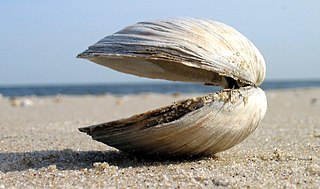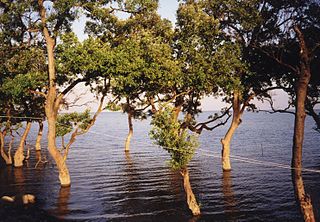
Clam is a common name for several kinds of bivalve molluscs. The word is often applied only to those that are edible and live as infauna, spending most of their lives halfway buried in the sand of the seafloor or riverbeds. Clams have two shells of equal size connected by two adductor muscles and have a powerful burrowing foot. They live in both freshwater and marine environments; in salt water they prefer to burrow down into the mud and the turbidity of the water required varies with species and location; the greatest diversity of these is in North America.

The Pacific razor clam, Siliqua patula, is a species of large marine bivalve mollusc in the family Pharidae.

Ensis is a genus of medium-sized edible saltwater clams, littoral bivalve molluscs in the family Pharidae. Ensis, or razor clams, are known in much of Scotland as spoots, for the spouts of water they eject while burrowing into the sand, when visible at low tide. This term may also colloquially include members of the genus Solen. Ensis magnus are known as bendies due to their slightly curved shell.

Don Hoi Lot is a sandbar off the coast of Samut Songkhram Province at the northwestern tip of the Bay of Bangkok. The sediments of the Mae Klong River together sediments from the sea form a system of mudflats, which are populated by razor clams, which also gave the site its Thai name. The site has the largest population of this species, which is endemic to the northern Gulf of Thailand. Also 18 bird and 42 invertebrate species are recorded at the mudflats and the adjoining coastal mangrove forests. The mudflat Don Nai is on the coast. Nearby, the highly revered shrine of Prince Chumphon Khet-Udomsak attracts Thai visitors.
Razor clam is a common name for long, narrow, saltwater clams, including:

The Atlantic jackknife clam, Ensis leei, also known as the bamboo clam, American jackknife clam or razor clam, is a large edible marine bivalve mollusc found on the North American Atlantic coast, from Canada to South Carolina. The species has also been introduced to Europe. The name "razor clam" is also used to refer to different species such as the Pacific razor clam or Razor shell.
Jackknife clam is a common name which is used for several species in the genera Ensis and Solen within the family Solenidae, species which are found on Atlantic and Pacific beaches of temperate North America. Species in these families are also found elsewhere in the world, but in other English-speaking countries they usually have other common names. All the species in these genera have thin, highly elongate shells. Many of these bivalves are collected for food.
Freshwater bivalves are one kind of freshwater mollusc, along with freshwater snails. They are bivalves that live in fresh water as opposed to salt water, which is the main habitat type for bivalves.

The razor shell, Ensis magnus, also called razor clam, razor fish or spoot (colloquially), is a bivalve of the family Pharidae. It is found on sandy beaches in Canada and northern Europe.

Pharidae is a taxonomic family of saltwater clams, marine bivalve molluscs in the order Adapedonta. This family of clams is related to the razor shells, a family which is considered to include Pharidae by some authorities.
In 1758, in the 10th edition of Systema Naturae, the Swedish scientist and taxonomist Carl Linnaeus described the class "Vermes" as:
Animals of slow motion, soft substance, able to increase their bulk and restore parts which have been destroyed, extremely tenacious of life, and the inhabitants of moist places. Many of them are without a distinct head, and most of them without feet. They are principally distinguished by their tentacles. By the Ancients they were not improperly called imperfect animals, as being destitute of ears, nose, head, eyes and legs; and are therefore totally distinct from Insects.

The Solecurtidae are a family of saltwater clams, marine bivalve molluscs in the order Cardiida.

Gould's razor shell is a bivalve mollusc of the family Solenidae. It is common in Japan in sandy coastal zones of the western, southern and northeastern coasts, and also in South Korea, China and Taiwan. It lives on the sandy littoral zone, preferring the depth of about 20–50 cm.

Solen is a genus of marine bivalves in the family Solenidae.

Solen marginatus, common name "grooved razor shell", is a species of marine bivalves in the family Solenidae.

Pharus legumen, is a species of bivalve mollusc commonly found burrowed in the sand on lower shores and in the shallow sublittoral.
Solen was a Swedish 17th-century galleon ship, sunk during the battle with the Polish squadron at Oliwa on November 28, 1627.









